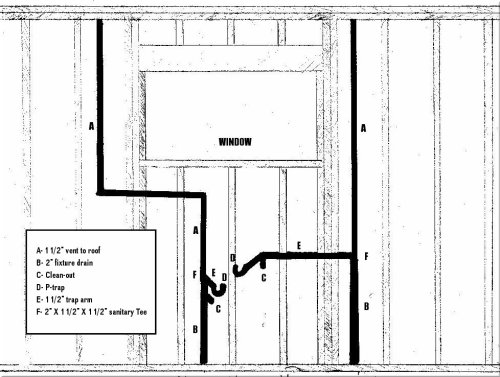Trap arm or dirty arm?
When a trap arm extends laterally through a stud wall inside of the wall, we call it a dirty arm. I don't know who came up with the name dirty arm for that fixture rough-in configuration. It's what I was told to call it in '78.
My diagram below shows the difference between a standard rough-in (left hand scenario), and a dirty arm rough-in (right hand scenario).

There are two ways to determine if you have a dirty arm rough-in. Check the drain center below the floor to see if it matches the center of the trap arm above or to remove the trap arm to see if the drain goes down (normal scenario) , or to the side (dirty arm scenario).
The advantages of a dirty arm configuration are location of the drain center, and the lack of a re-vent. There are times when the drain may encounter an obstacle if it is roughed-in on-center with the fixture. The side rough-in may clear the path for an easier installation. Thus a dirty arm gives more rough-in options.
The re-vent of a fixture is the vent pipe section that is installed in a horizontal attitude between two or more vertical sections of vent pipe. A dirty arm rough-in may have no re-vent.
This becomes an issue when the re-vent for a normal rough-in would be forced to be installed below the spill level of the fixture by the way the window is framed. I would typically solve the vent height problem by using drainage fittings instead of vent fittings on the below grade section of the fixture vent, a more expensive layout but still code and in my opinion more sanitary.
“But what does this have to do with snaking drains,” you ask?. There are two issues with dirty arms that apply to drain cleaning.
- It is not possible to be sure the cable is going down the drain and not up the vent if the sanitary tee is a few feet to the left or right in the wall, instead of right behind the opening in the wall the pipe emerges from.
- If the piping is of an age to be cast or galvanized iron it may be subject to fail in an expensive way. Horizontal sections of iron waste pipe fail faster than vertical sections because they retain more solid and liquid residue than vertical sections do.
This is seen at kitchen waste pipes more than anywhere else due to the caustic nature of dish soap. The problem with a dirty arm rough-in in a kitchen is the first horizontal section is behind the cabinets in an outside wall above the floor. Replacing that piece of pipe when it rots and leaks is always a big problem. It makes a mess in the wall that is hard to detect until it is long term, thus it invites insects. It's also a difficult and invasive task to undertake unless it is done in conjunction with a scheduled remodel.
For these reasons be extra wary how you treat a dirty arm drain that is piped in iron. If you remodel, go the extra mile of opening up the wall to re-pipe it in plastic.